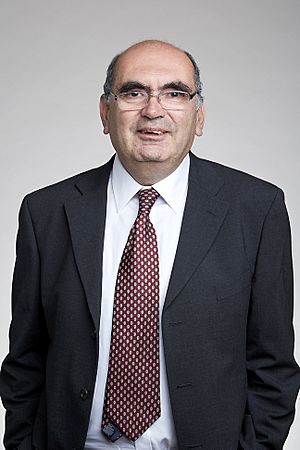Sandu Popescu facts for kids
Quick facts for kids
Sandu Popescu
|
|
|---|---|

Popescu at the Royal Society admissions day in London, July 2017
|
|
| Born | 1956 (age 68–69) Oradea, Romania
|
| Known for |
|
| Awards |
|
| Scientific career | |
| Fields | Physics |
| Institutions | University of Bristol |
| Doctoral advisor | Yakir Aharonov |
Sandu Popescu is a physicist from Romania and Britain. He was born in 1956 in Oradea, Romania. He studies the basic ideas of quantum mechanics and quantum information. These are complex areas of physics that explore how tiny particles behave.
Sandu Popescu's Journey in Physics
Sandu Popescu studied with famous scientists like Yakir Aharonov. After his studies, he worked as a researcher with other important physicists.
Working at Top Universities
From 1996 to 1999, he worked at the Isaac Newton Institute at the University of Cambridge. Since 1999, he has been a Physics Professor at the University of Bristol. He also helped write one of the first textbooks about quantum information. In 2015, he appeared on the TV show Through the Wormhole with Morgan Freeman.
Exploring the Quantum World
Professor Popescu's most important work is about something called quantum nonlocality. This is a strange property of nature. It means that two tiny particles can be connected in a way that seems to defy distance.
Understanding Quantum Nonlocality
With his colleague Daniel Rohrlich, Popescu showed that nonlocality is very common. Almost all entangled quantum states have these nonlocal properties. Entangled states are when two particles are linked, even if they are far apart.
Manipulating Entanglement
Popescu also worked with Charles Bennett and others. They developed ways to measure and change entanglement. They found methods to "purify" entanglement. This means making the connection between particles stronger and clearer. Their work helped create the idea of manipulating entanglement using only local operations and classical communication (LOCC).
Popescu-Rohrlich Boxes
With Daniel Rohrlich, Popescu explored something even stranger. They showed that correlations stronger than those in quantum mechanics could exist. These would not break Einstein's rule that nothing can travel faster than light. These ideas are now called Popescu-Rohrlich correlations, or PR boxes. This research helps scientists look for new rules that explain why quantum mechanics works the way it does.
Quantum Teleportation
In 1997, Popescu was one of the first scientists to achieve quantum teleportation. This is a landmark experiment in quantum information. It involves transferring quantum information from one place to another.
How Quantum Systems Reach Balance
Another area Popescu is interested in is how systems reach a state of balance. With his team, he showed that almost any quantum system will reach balance if it interacts with a larger system. This is important for understanding how things work in the universe. It helps explain how systems settle down without needing extra assumptions.
Quantum Paradoxes
With Yakir Aharonov and his group, Popescu discovered several quantum paradoxes. These include the quantum Cheshire cat and the quantum pigeonhole principle. These ideas show how counter-intuitive quantum theory can be. They also introduced the idea of superpositions of time evolutions.
Optimal Measurements and Information
Popescu also studied how to make the best possible measurements in quantum physics. He found that you often need to measure all particles in a group together. He also discovered that two spins pointing in opposite directions can hold more information than parallel spins.
Thermodynamics of Quantum Systems
More recently, Popescu has been interested in the thermodynamics of quantum systems. This is about how heat and energy work at the quantum level. With his colleagues, he described the smallest possible refrigerator. He also helped extend the laws of thermodynamics to individual quantum systems.
Awards and Recognitions
Professor Popescu has received many awards for his important work.
- 2017: Elected a Fellow of the Royal Society. This is a very high honor for scientists.
- 2016: Received the Dirac Medal from the Institute of Physics.
- 2012: Awarded the Wolfson Research Merit Award by the Royal Society.
- 2011: Won the John Stewart Bell Prize.
- 2004: Gave the Clifford Paterson Lecture at The Royal Society.
- 2001: Awarded the Adams Prize by the University of Cambridge.

